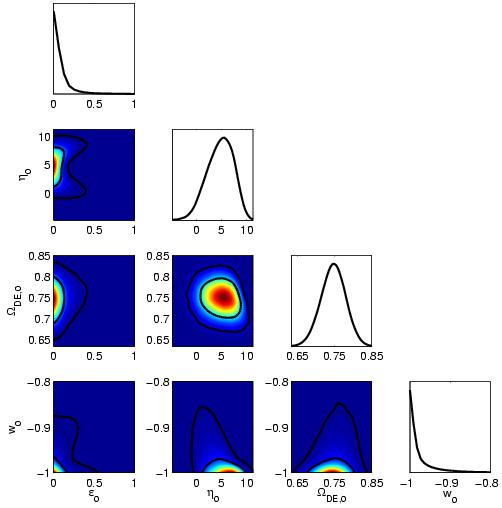
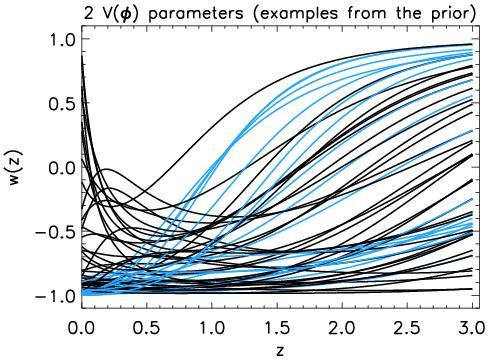
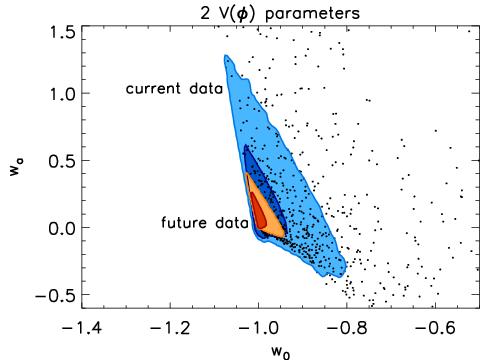
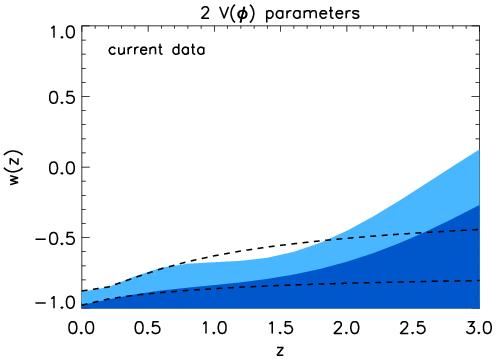
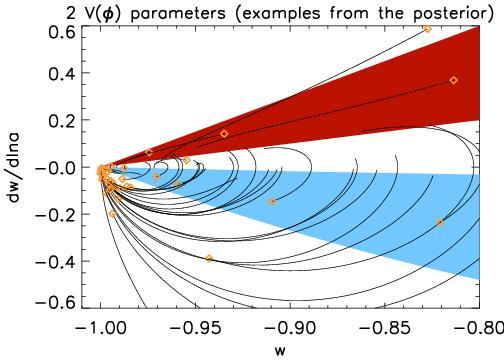





For each class of models and (current or future) cosmological data, there are are four chains (in four files) contained in a .tar.gz tarball. For each class, there are additional four files that contain the w(z) history for each model. The classes of models we have assumed are 2 and 3-parameter V(&phi) models with either current or future data.
2 parameter V(&phi), current data (75 Mb file):
Columns are, for the 2-V(&phi)-parameter case (these parameters,
for each model, are written in a single row)
While we give the likelihood of individual models for reference, the
posterior must be calculated using the weights of the models which are
proportional to the PDF (Bayes Theorem). Our chains are fully
compatible with the GetDist parameter estimation package, supplied as
part of cosmomc, with
minor modifications to the parameter file to change the variable names
to those that we use.
2 parameter V(&phi), future data (67 Mb file):
3 parameter V(&phi), current data (56 Mb file):
3 parameter V(&phi), future data (92 Mb file):
weight, -ln(Likelihood)
&epsilon(3), &eta(3), &OmegaDE(3), w(3),
&thetaA, &Omegabh2,
&epsilon(0), &eta(0), &OmegaDE(0), w(0),
&thetaA, &Omegabh2,
&alpha1, &alpha2, &alpha3,
w0, wa
where the parentheses show whether the parameter was
evaluated at z=3 (our starting redshift) or z=0. Here &epsilon and
&eta are the two "slow-roll" parameters (note they are not necessarily
small for DE), and &OmegaDE, and w are energy density and
equation of state of DE. Further,
&thetaA and &Omegabh2 are the CMB angle
subtended by the first peak (in degrees) and baryon fraction
respectively; note they are repeated twice in the files. Finally,
&alphai (i=1, 2, 3) are the first three principal
components of the equation of state, while w0 and
wa are derived from the PCs as described in the paper.
For the 3-V(&phi)-parameter case there is one extra parameter, the
third "slow-roll" parameter &xi and the format is now
weight, -ln(Likelihood)
&epsilon(3), &eta(3), &OmegaDE(3), w(3),
&thetaA, &Omegabh2 &xi(3),
&epsilon(0), &eta(0), &OmegaDE(0), w(0),
&thetaA, &Omegabh2 &xi(0),
&alpha1, &alpha2, &alpha3,
w0, wa
Finally, for the "_wz" files the format is
weight, -ln(Likelihood), w(0.0), w(0.2),... w(3.0)
where w(z) refers to value of the equation of state at redshift z in
each model.
Dragan
Huterer